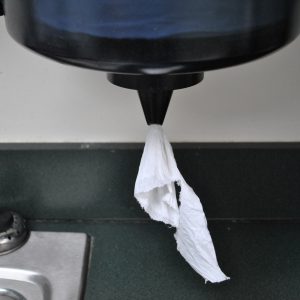Article and audio introduction by Samantha Kennedy, Family and Consumer Sciences

If you are anything like me, kitchen cleanliness is very important. Everything is tidy and in its place, there is no expired food in the pantry or refrigerator, and all the appliances are clean and free of debris.
But really. How clean is your kitchen? Out of curiosity, I recently graded the cleanliness of my own kitchen using the Home Kitchen Food Safety Best Practices Checkup from Rutgers University. While I received a pretty good grade, there were a few things I discovered I was not doing correctly. As a food safety instructor, I was ashamed of myself!
5 Things I Overlooked
- While the inside of my microwave oven was clean and free of debris, I failed to pay enough attention to the door. It was a little grubby. While it may not seem important to keep it clean since it does not come in contact with food, gunky buildup from food and other sources can harbor bacteria. Be sure to always keep the door clean.
- I have a bad habit of using the same dishtowel to dry my hands that I use for other functions in the kitchen. The best food safety practice is to either use paper towels for hand drying or have a designated towel for hand drying. In fact, dishtowels should only be used to dry dishes, not to wipe down countertops or clean up spills.
- While I hate to admit it, I have sometimes resorted to thawing foods on the counter when I have realized that one of the ingredients for that night’s dinner is still in the freezer. THIS IS A VERY UNSAFE PRACTICE! There are only 4 acceptable methods for safely thawing foods:
- In the refrigerator.
- Under running water. (NOTE: The water temperature must always be less than 70 degrees F.)
- In the microwave. (NOTE: The food must be cooked immediately after thawing.)
- During the cooking process.
Thawing foods at room temperature (i.e. on the counter) exposes foods to the Temperature Danger Zone, which can encourage the growth of pathogens. The Temperature Danger Zone is the range of temperatures between 41 and 135 degrees F. Keep cold foods below 41 degrees and hot foods above 135 degrees to reduce the risk of foodborne illness.
- I do not actually store a lot of leftovers. As a single person, I generally prepare small meals that can be eaten in one sitting. However, on those occasions when I do have leftovers, I do not always label them with the date. Leftovers stored in the freezer should especially be labeled with what it is and when it was put into the freezer. Refrigerated leftovers should not be kept longer than 7 days. Frozen leftovers should not be kept longer than 6 months.
- I do not keep a thermometer in my refrigerator and freezer. However, it is good practice to do so to ensure that the appliance is maintaining the proper temperatures for food safety. The refrigerator should be between 37 and 39 degrees. The freezer should be at or below 0 degrees.
How do you think your kitchen would fare? I encourage you to take a few minutes to grade your own kitchen to make sure you are doing everything you can to keep your kitchen as clean and sanitary as possible.
For more information about food safety and kitchen cleanliness, please contact Samantha Kennedy at (850) 926-3931.
RELATED ARTICLE: Get a Jump Start on Your Spring Cleaning by Kendra Zamojski
Extension classes are open to everyone regardless of race, creed, color, religion, age, disability, sex, sexual orientation, marital status, national origin, political opinions or affiliations.
 0
0
